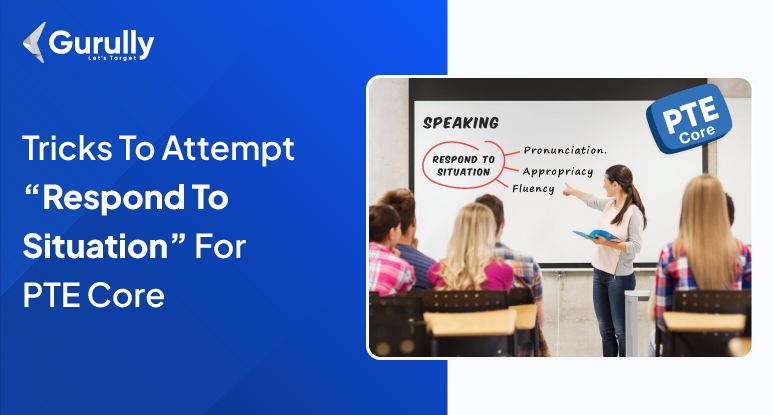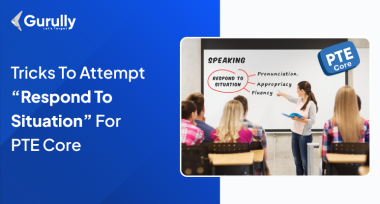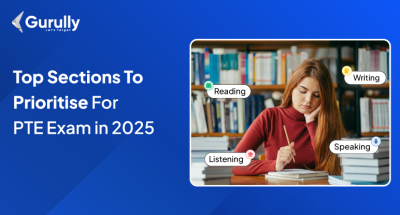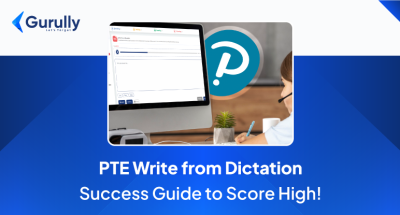As PTE Core was launched recently, there has always been a buzz about what has been changed and added to the question format. There are two major changes in question types, “Respond to a Situation” and “Write Email,” in the Speaking & writing section. You might not know these two question types, especially “PTE Respond to a Situation.”
So here are the secrets to scoring well in this question type of PTE Core 2024.
What Is PTE Respond To A Situation Question Type
Imagine yourself in a real-life situation. The “Respond to a Situation” exercise replicates that experience, presenting you with a brief text prompt outlining a common scenario. Your job? Respond verbally as you would naturally in that situation. Sounds simple, right? The time pressure and need for clear, concise communication make it a unique challenge.
Key Points to Remember:
- Time Constraints: You’ll get 20 seconds to analyze and respond. After that, you have 40 seconds to speak. Make every second count!
- One Shot: You only get one chance to record your response. So, think before you speak, but don’t take too long.
- Start Strong: After the prompt, you have 3 seconds to speak. Seize the moment and launch into your response confidently.
- Word Limit: Aim for a response between 30-40 words. Brevity is key, but don’t sacrifice clarity for conciseness.
Strategies To Crack “Respond To A Situation” Question Type:
Pay Attention To Sentence Formation:
The PTE Core uses automated scoring to evaluate your spoken English. So, try to frame the sentence properly while speaking. Here are some tips that you can apply.
- The situation might require using past, present, or future tenses to describe events. Be prepared to adjust your sentence structure accordingly.
- Ensure your verbs agree in number (singular or plural) with the sentence’s subject.
- Simple words like “and,” “but,” “because,” or “however” can help you connect ideas and build logical sentences.
- Use a mix of short and longer sentences to add variety to your speech.
- Master basic sentence structures like subject-verb agreement, proper verb tense usage, and correct word order.
Practice Fluency:
Fluency refers to the smooth and effortless delivery of your spoken or written language. It’s about expressing yourself clearly and confidently without stumbling or hesitating. Here’s how to practice fluency:
- Read Aloud Regularly: Reading different types of material (books, articles, news) helps train your brain to process and vocalize language naturally.
- Speak with Others: Converse with friends, family, or language partners. The more you speak, the more comfortable and fluent you become.
- Shadowing: Listen to native speakers and try to repeat what they say, mimicking their pace, intonation, and phrasing.
- Focus on Everyday Language: Instead of complex vocabulary, prioritize words and phrases commonly used in conversation.
Enhance Vocabulary:
The more words you have, the more precise and nuanced your response can be. Focus on vocabulary relevant to everyday situations and expressing common emotions and requests. Here are some examples
Enhancing Social Interactions:
- Greetings: Beyond “hello,” explore options like “good morning/afternoon/evening,” “how are you doing today?” or “it’s nice to see you.”
- Requests: Use phrases like “I was wondering if you could…” or “I’d be grateful if you could…”
- Apologies: Express regret with “I’m so sorry” or “That was my mistake.”
- Offering Help: Be proactive with “Let me know if you need anything” or “I’d be happy to assist you.”
Tackling Consumer Issues:
- Faulty Products: Describe problems with words like “malfunctioning,” “defective,” or “not working properly.”
- Complaints: Express dissatisfaction with “I’m disappointed with…” or “I’m not satisfied with…”
- Returns/Exchanges: Use phrases like “I’d like to return…” or “I need to exchange this for…”
Navigating Workplace Dilemmas:
- Addressing Behavior: If a colleague acts poorly, use terms like “disruptive,” “inappropriate,” or “unprofessional.”
- Requesting Extensions: Ask for more time with phrases like “I was hoping to get an extension on…” or “Would it be possible to move the deadline for…?”
- Seeking Clarification: When unsure, say, “I’m not sure I understand…” or “Could you please elaborate on…?”
Time Management:
Time is very important, so follow these tips to manage it effectively in PTE Core exam.
- Aim to understand the meaning of the conversation within the first half of the audio, leaving you time to process details and answer questions.
- Not every detail in the audio is equally important. Train yourself to identify keywords and phrases that directly relate to the potential questions.
- If you miss a detail or get confused, don’t dwell on it. Move on to the next piece of information, as the answer might lie further in the audio.
- Even if you’re unsure, take a guess. There’s no penalty for incorrect answers in the PTE.
Active Listening:
Mastering this skill will allow you to extract the core and relevant information. Here are tips for doing that.
- Listen for clues (tone, word choice) to understand the speaker’s purpose.
- As you listen, try to predict what information the questions might ask about. This will help you focus on relevant details and prepare mentally.
- Train yourself to recognize words and phrases that signal important information. These might include nouns related to people, places, things, and actions.
- Excessive note-taking can distract you from the audio. Instead, develop a shorthand system for jotting down critical details like names, dates, or locations.
- As the audio progresses, summarize the situation mentally in simple terms.
Want to know what exam will suffice your needs, check PTE Core Vs PTE Academic
Example Question of ‘Respond to A Situation’ In PTE Core
Question:
You’re at a new bakery and feeling overwhelmed by the vast selection of pastries. How do you approach the staff and inquire about their recommendations?
Answer:
I approached the counter and politely introduced myself. “Excuse me,” I began, “This is my first time here, and the pastries look amazing! Could you recommend one of your most popular items or perhaps something that pairs well with a cup of coffee?” The barista’s expression warmed. They enthusiastically described a few of their favorites, explaining the flavors and ingredients. Based on their description, I chose [name of pastry] and a [coffee choice]. Feeling confident in my selection, I thanked the barista for their helpful recommendation. I can’t wait to try it!
Knowing the strategies is not enough; you must practice them thoroughly. Gurully provides you with a full-length mock test on which you can practice for PTE Core. We also have separate practice tests section-wise and question-wise. Explore the practice platform, and you can choose a day-wise plan for last-moment practice.
Conclusion:
PTE Respond to a Situation section is not about memorizing specific responses. It’s about demonstrating your ability to use English naturally and effectively in everyday situations. By following these strategies and practicing regularly, you’ll be well on your way to conquering this section of the PTE Core.
With dedication, practice, and the right approach, you can transform your “PTE Respond to a Situation” responses from a challenge to an opportunity to showcase your fluency and communication skills. Now go forth and ace that test!







